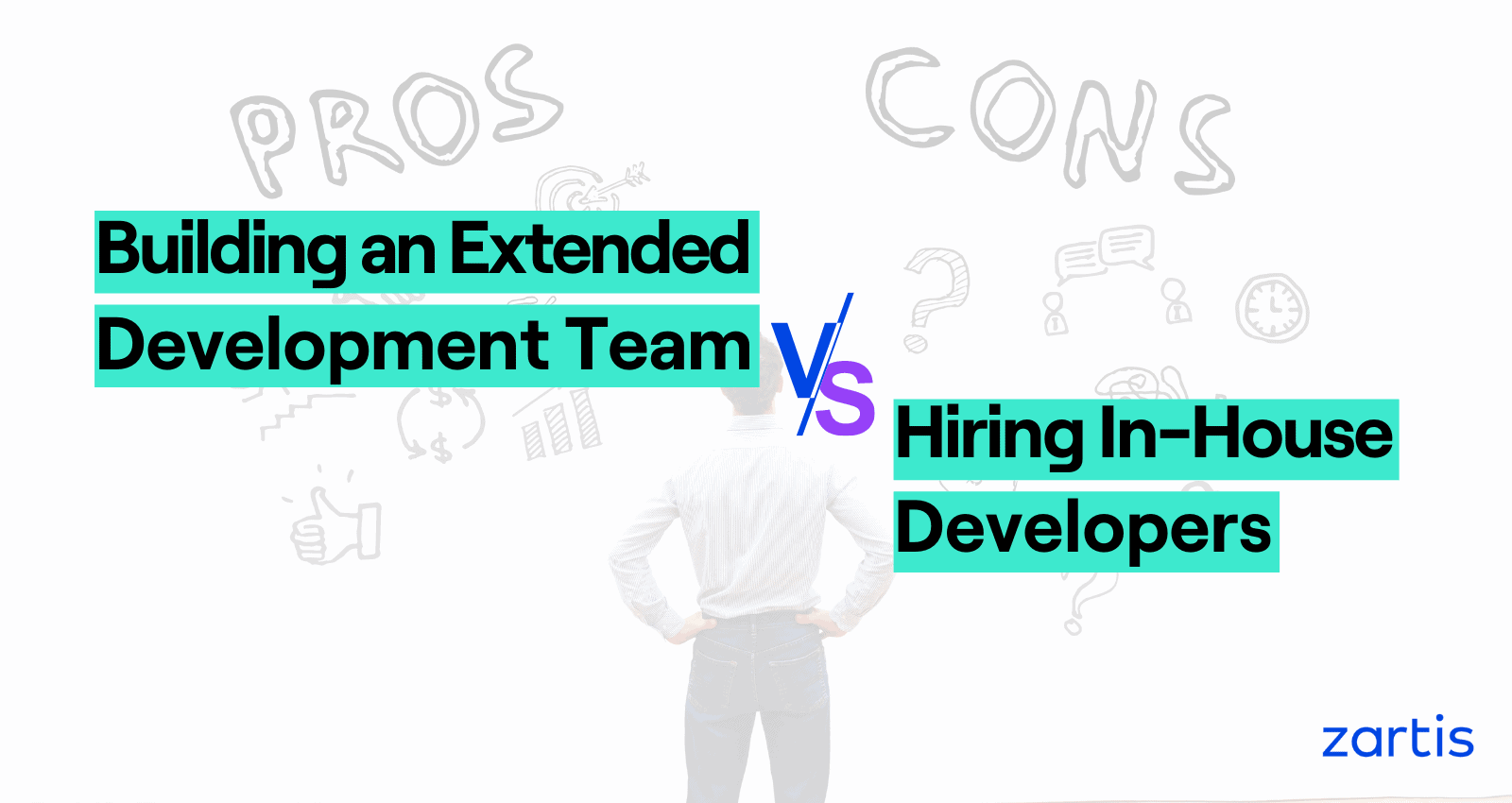What do you do when you need fresh talent on your developer team? It’s simple: you bring in new engineers. So far, so good.
However, before you embark on a head-hunting mission, you need to answer a second, bigger question: should you hire people directly or use an external provider instead?
And if you’d rather not hire in-house, should you opt for offshore outsourcing or an extended development model?
What Is Extended Software Development?
Under the extended development model, also known as staff augmentation or nearshore outsourcing, a band of remote engineers located in a nearby country work in close collaboration with your in-house team. The development process is not fully outsourced. Instead, the two teams work side-by-side and have common goals.
Should You Hire In-House or Get an Extended Team?
While offshore outsourcing has its benefits, it’s not a viable alternative to increasing your core team. Extended development, however, is.
So, to help you find the best solution for your company, we drew up a list of the pros and cons of hiring in-house versus the advantages of extended software development.
Pros of Hiring In-House
+ It Can Be Easier to Build a Company Culture
When all your software developers form a single tight-knit unit, as a project manager, you will have nearly complete control over most internal processes. That makes it much easier to establish a company identity and reinforce a uniform corporate culture.
+ Everyone Is in the Same Office
One of the key benefits of hiring in-house is that all members of your software development team share the same office space. While pretty much everything can be done remotely these days, direct communication can make whiteboarding, brainstorming, and discussing complex issues smoother and more effective. Sometimes, conference calls just don’t cut it.
+ More Efficient Training and Onboarding
Training and onboarding new hires in person can help everyone get on the same page more quickly. Engineers can ask questions and get answers in real time, and some people find it easier to absorb new information in a more traditional “classroom” environment than via online trainings.
Cons of Hiring In-House
– Limited Flexibility
For all its advantages, increasing your core staff comes at a cost. Permanent contracts make it difficult to quickly scale down your team if needed. That limits your ability to respond to changing project needs and market demands.
– It’s More Expensive
Recruiting, hiring, onboarding, and training software developers in-house can be considerably more expensive than building a remote team. You also have to think about operational expenses such as setting up physical workstations, ensuring your engineers have all the equipment they need, and much more. So, if you’re running on a tight budget, you might want to look into cheaper options.
– Smaller Talent Pool
Depending on your location, budget, and project type, finding suitable candidates among local talent can be anything from challenging to downright impossible. Developers with highly sought-after skill sets can be few and far between. Plus, even if you do find them locally, you may not be able to afford them.
– The Process Is Time-Intensive
Recruiting engineers in-house is a laborious and drawn-out process in the best of circumstances. However, it can be made even longer by legal and administrative hurdles such as the mandatory notice periods in some countries. In Germany, for instance, these can take up to six months!
Pros of Building an Extended Development Team
+ It’s More Cost-Effective
The extended team model allows you to assemble a stellar team extension at a fraction of the cost of hiring developers in-house. You get to save money and fill skill gaps in your core team at the same time, killing two birds with one stone.
+ Less Hassle
Unlike standard in-house recruitment, building an extended team comes with practically no operational hassle. Most of the work is done remotely, so you don’t have to worry about buying and setting up equipment and workstations, renting and maintaining an office space, enabling home-office setup, payroll, and employee benefits.
+ Faster Time-to-Market
You can have your remote team up and running at maximum capacity in a couple of weeks. Plus, most of the heavy lifting is done for you. Your service provider will take care of the sourcing, testing, and interviewing of potential candidates, saving you even more time.
+ Unparalleled Flexibility
Even if you require a certain number of software developers now, that doesn’t mean you will be needing them in a few months or a year. What if you have to downsize? What if you need more engineers?
One of the key benefits of the extended team model is that it allows you to quickly and easily scale your team up or down as needed — with minimal red tape and operational hassle.
Cons of Building an Extended Development Team
– Onboarding, Training, and Brainstorming Become More Complex
If you have no experience in working with remote or extended teams, certain internal processes will need some adjusting.
For starters, you would need to migrate your onboarding and trainings online.
You should also reconsider how you organize company meetings. It has to be done in a way that enables constructive debate, the sharing of ideas, and brainstorming — and all that needs to take place remotely and without having a whiteboard in front of you.
When possible, in a post-COVID world, it’s also a good idea to get everyone in the same room for important discussions once in a while.
– Establishing a Shared Company Culture Across the Board Can Be Challenging
Does building a deep-rooted sense of belonging to the company and a uniform corporate culture matte a lot to you? If that’s a yes, you should consider increasing your core staff rather than getting a team extension. Your developers will probably find it easier to establish a close emotional connection with their coworkers if they share the same physical space.
If you end up opting for an extended team, however, make sure the service provider shares your company values. That should make your collaboration as smooth as possible.
– You Might Pick the Wrong Model or Provider
Outsourcing requires you to entrust your product development to another company and team — at least to some extent. There’s no getting around it. That’s why you want to make sure you pick the right model for your needs and a partner with a proven track record.
Ask yourself: is extended development the best option for your project? Could traditional outsourcing be a better fit?
And as far as the provider goes, what processes do they have in place to ensure efficient collaboration? What’s their stance on security (e.g., ISO certifications)? What is their selection process? How do they ensure they are recruiting strong developers? What’s their company culture, and does it match yours?
Other Cases Where You May Need an Extended Team
You could also benefit from the extended team model when:
- You are in a time crunch
- Your in-house team lacks expertise for a specific project
- For whatever reason, it is not possible to hire in-house
- You want to lower risk and increase flexibility
For a more in-depth discussion on this topic, check out these posts:
- 5 Specific Cases Where You Need an Extended Development Team
- 5 Benefits of Having an Extended Development Team
Setting Up an Extended Software Development Team with Zartis
Whether you are based in the US, the UK, Ireland, Germany, or beyond, benefit from our customisable team augmentation services.
Not sure where or how you should outsource yet?
We can help you find out. Simply drop us a line using our contact form.
Our team will be in touch shortly. Depending on your business objectives, we will give you our expert opinion on whether getting an extended team or increasing your core staff would be a better solution for you.



